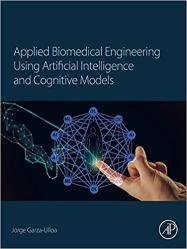 Название: Applied Biomedical Engineering Using Artificial Intelligence and Cognitive Models
Название: Applied Biomedical Engineering Using Artificial Intelligence and Cognitive ModelsАвтор: Jorge Garza-Ulloa
Издательство: Academic Press, Elsevier
Год: 2022
Страниц: 705
Язык: английский
Формат: pdf (true)
Размер: 37.1 MB
Applied Biomedical Engineering Using Artificial Intelligence and Cognitive Models focuses on the relationship between three different multidisciplinary branches of engineering: Biomedical Engineering, Cognitive Science and Computer Science through Artificial Intelligence models. This book aims to help people understand the importance of applying Artificial Intelligence (AI) and cognitive models following the development of mathematical models to be applied to many illnesses, diseases, and injuries with a special focus on nonmotor aspects of neurologic disease process using a biomedical engineering dataset to be analyzed, processed, classified, and predicted and obtain many AI models to help in the developing of solutions that can be implemented in a standalone way or in revolutionaries new frameworks as the Proposed General Architecture framework of a Cognitive Computing Agents System (AI-CCAS) with special emphasis in their relationship with neuroscience of reasoning based on Cognitive Learning and Reasoning (CL&R) using Cognitive Computing (CC).
These actions can be detected by many Bioinstruments (Biomedical Instruments) and cognitive device data, allowing us to apply AI using Machine Learning-Deep Learning-Cognitive Computing models through algorithms to analyze, detect, classify, and forecast the process of various illnesses, diseases, and injuries of the human body.
Applied Biomedical Engineering Using Artificial Intelligence and Cognitive Models provides readers with the study of injuries, illness, and neurological diseases of the human body through Artificial Intelligence using Machine Learning (ML), Deep Learning (DL) and Cognitive Computing (CC) models based on algorithms developed with MATLAB and IBM Watson.
Key Features:
Provides an introduction to Cognitive science, cognitive computing and human cognitive relation to help in the solution of AI Biomedical engineering problems
Explain different Artificial Intelligence (AI) including evolutionary algorithms to emulate natural evolution, reinforced learning, Artificial Neural Network (ANN) type and cognitive learning and to obtain many AI models for Biomedical Engineering problems
Includes coverage of the evolution Artificial Intelligence through Machine Learning (ML), Deep Learning (DL), Cognitive Computing (CC) using MATLAB as a programming language with many add-on MATLAB toolboxes, and AI based commercial products cloud services as: IBM (Cognitive Computing, IBM Watson, IBM Watson Studio, IBM Watson Studio Visual Recognition®), and others
Provides the necessary tools to accelerate obtaining results for the analysis of injuries, illness, and neurologic diseases that can be detected through the static, kinetics and kinematics, and natural body language data and medical imaging techniques applying AI using ML-DL-CC algorithms with the objective of obtaining appropriate conclusions to create solutions that improve the quality of life of patients
Table of Contents:
Chapter I. Biomedical Engineering and the evolution of Artificial Intelligence
Evolution of Artificial intelligence (AI) through Machine Learning (ML), Deep Learning (DL), Cognitive Computing (CC) using MATLAB and AI-based commercial products cloud services as: IBM (Cognitive Computing under IBM Watson), and others.
Chapter II. Introduction to Cognitive science, cognitive computing and human cognitive relation to help in the solution of AI Biomedical engineering problems.
Natural Language Processing (NLP) examples and exercise as: NLP Topics, Audio Labeler for Machine Learning, NLP Text to speech, NLP Speech to Text, NLP analysis for: Sentiment, Emotion, Keywords, Entities, Categories, Concept and Semantic Roles with MATLAB and API a set of functions and procedures allowing the creation of applications...
Chapter III. Artificial Intelligence models applied to Biomedical Engineering.
Artificial Intelligence and Biomedical Engineering: concepts, models, algorithms, and examples.
Chapter IV Machine learning models applied to Biomedical Engineering.
Machine Learning (ML) is studied as a subset of AI following the typical algorithm steps to obtain a prediction model based in pattern recognition in data using clustering, classifiers, and regression models.
Chapter V Deep Learning Models Principles applied to Biomedical Engineering.
Underlying principle of deep learning is a compositional nature of neural network inspired by the biological elements that forms the human brain, as a collection of nodes emulating brain neurons, and their neuron synapses connections as primary elements of a net, that combined form mid-level elements identified as artificial neural networks (ANN), which in turn are combined with different architectures to form more complex networks.
Chapter VI Deep Learning Models Evolution Applied to Biomedical Engineering.
Chapter VII Cognitive Learning & Reasoning models applied to Biomedical Engineering.
Скачать Applied Biomedical Engineering Using Artificial Intelligence and Cognitive Models